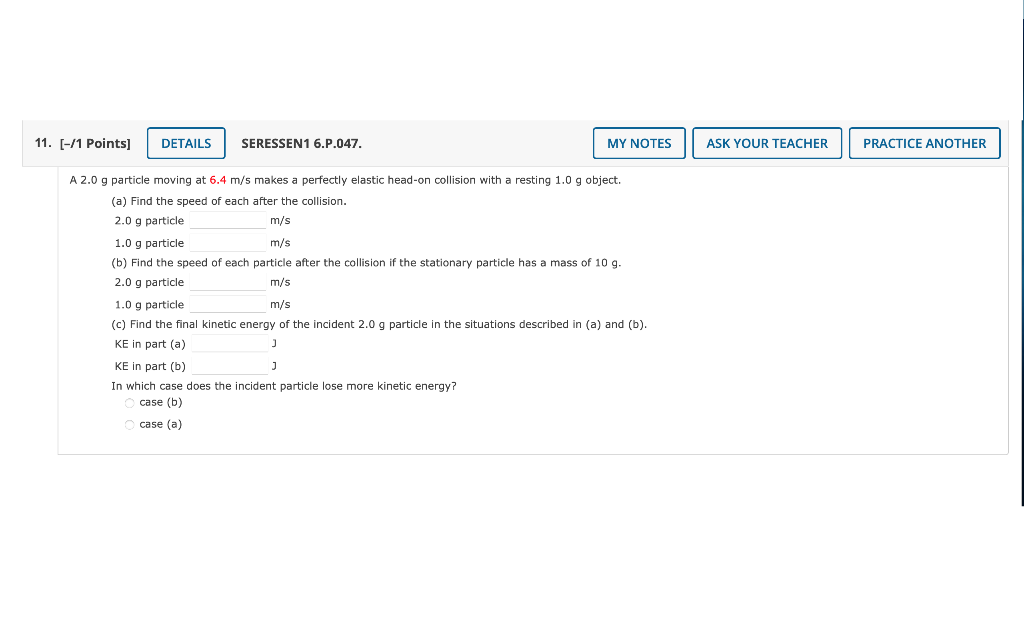Home /
Expert Answers /
Physics /
a-2-0-mathrm-g-particle-moving-at-6-4-mathrm-m-mathrm-s-makes-a-perfectly-el-pa407
(Solved): A \( 2.0 \mathrm{~g} \) particle moving at \( 6.4 \mathrm{~m} / \mathrm{s} \) makes a perfectly el ...
A \( 2.0 \mathrm{~g} \) particle moving at \( 6.4 \mathrm{~m} / \mathrm{s} \) makes a perfectly elastic head-on collision with a resting \( 1.0 \mathrm{~g} \) object. (a) Find the speed of each after the collision. \( 2.0 \mathrm{~g} \) particle \( \mathrm{m} / \mathrm{s} \) \( 1.0 \mathrm{~g} \) particle \( \mathrm{m} / \mathrm{s} \) (b) Find the speed of each particle after the collision if the stationary particle has a mass of \( 10 \mathrm{~g} \). \( 2.0 \mathrm{~g} \) particle \( \mathrm{m} / \mathrm{s} \) 1.0 g particle \( \mathrm{m} / \mathrm{s} \) (c) Find the final kinetic energy of the incident \( 2.0 \mathrm{~g} \) particle in the situations described in (a) and (b). \( \mathrm{KE} \) in part (a) J \( \mathrm{KE} \) in part (b) J In which case does the incident particle lose more kinetic energy? case (b) case (a)
[-/1 Points] WAS SERESSEN1 6.P.054.AF. A cue ball traveling at \( 3.0 \mathrm{~m} / \mathrm{s} \) makes a glancing, elastic collision with a target ball of equal mass that is initially at rest. The cue ball is deflected so that it makes an angle of \( 30^{\circ} \) with its original direction of travel. (a) Find the angle between the velocity vectors of the two balls after the collision. (b) Find the speed of each ball after the collision. cue ball \( \mathrm{m} / \mathrm{s} \) target ball \( \mathrm{m} / \mathrm{s} \) Hint: Active Figure \( 6.15 \) [-/1 Points] SERESSEN1 6.P.060. A \( 62 \mathrm{~kg} \) soccer player jumps vertically upwards and heads the \( 0.45 \mathrm{~kg} \) ball as it is descending vertically with a speed of \( 25 \mathrm{~m} / \mathrm{s} \). If the player was moving upward with a speed of \( 4.0 \mathrm{~m} / \mathrm{s} \) just before impact, what will be the speed of the ball immediately after the collision if the ball rebounds vertically upwards and the collision is elastic? \[ \mathrm{m} / \mathrm{s} \] If the ball is in contact with the player's head for \( 20 \mathrm{~ms} \), what is the average acceleration of the ball? (Note that the force of gravity may be ignored during the brief collision time.) \[ \mathrm{m} / \mathrm{s}^{2} \]
Expert Answer
11) m1 = 2 g m2 = 1 g u1 = 6.4 m/s u2 = 0 m/s collision type = elastic A) i) using the

![[-/1 Points]
WAS SERESSEN1 6.P.054.AF.
A cue ball traveling at \( 3.0 \mathrm{~m} / \mathrm{s} \) makes a glancing, elastic c](https://media.cheggcdn.com/media/1c5/1c53566c-5f03-4101-8737-1c5e99684e3c/phpHxxOhi)